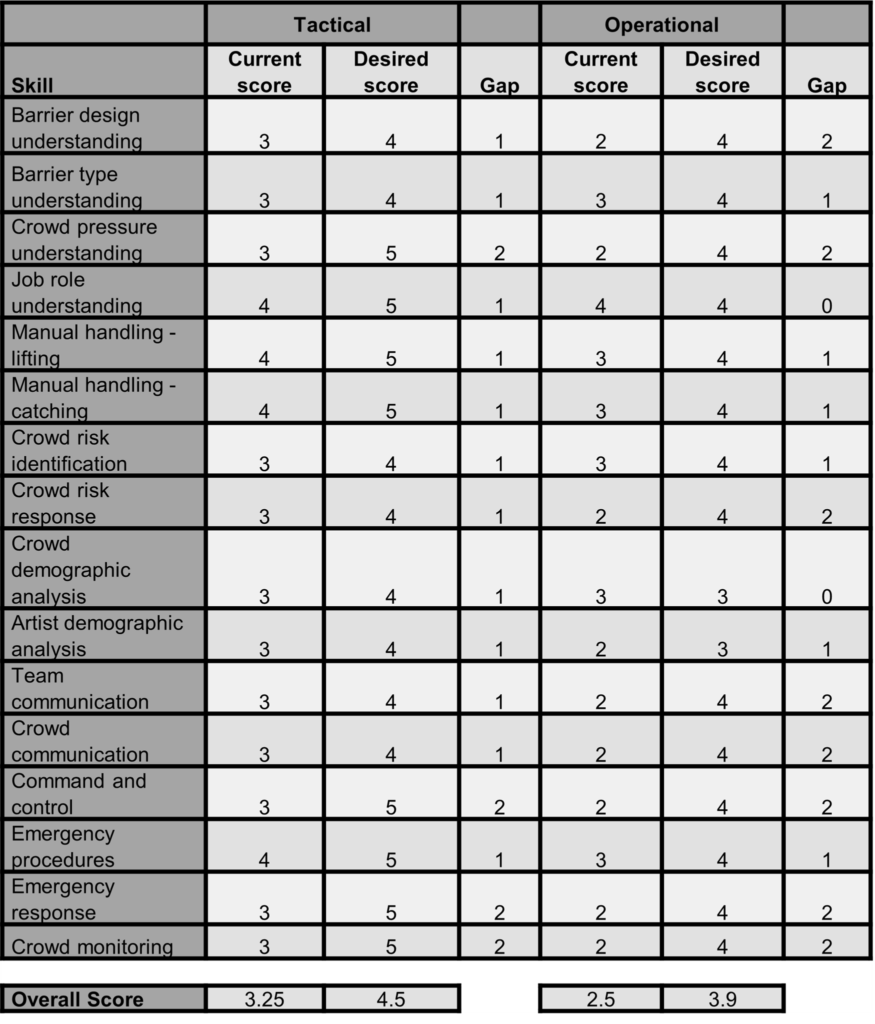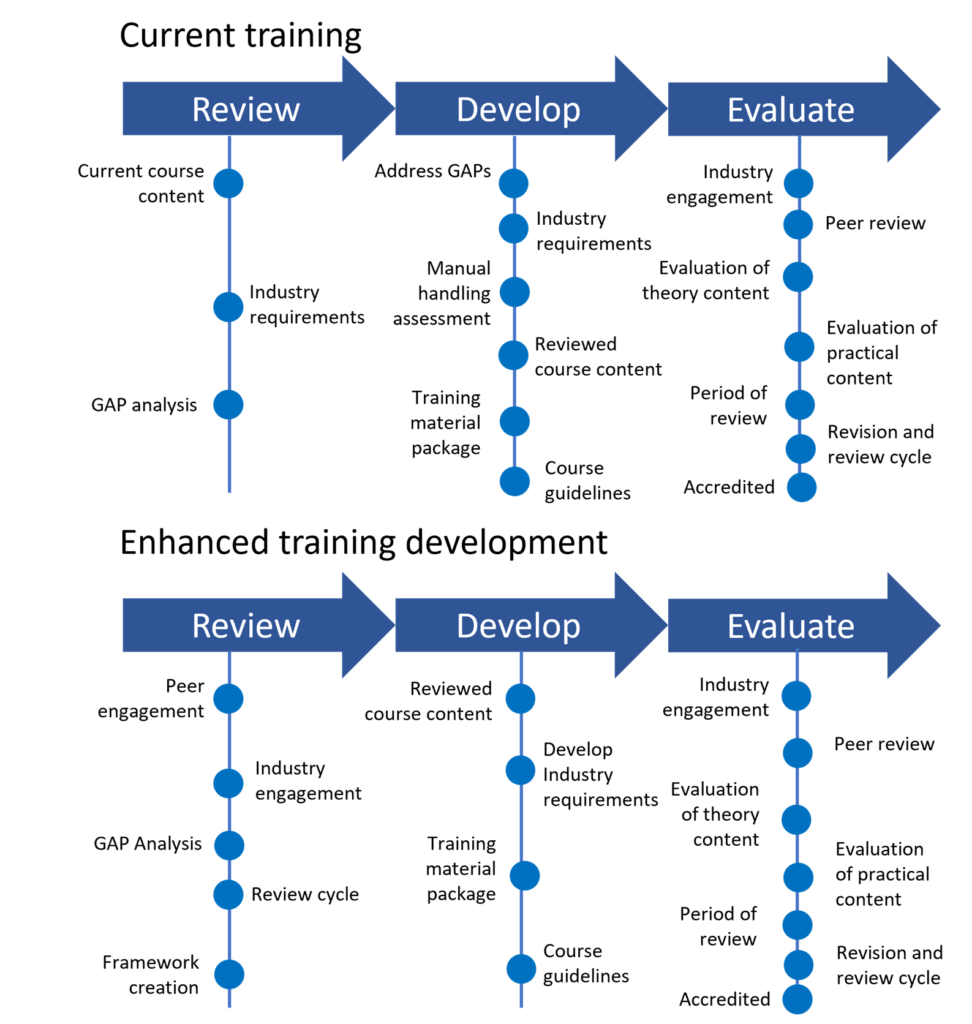
A comparative study of front of stage safety standards in crowded places
By Mark McQuade
Acknowledgements
The return path to further education was not one taken lightly. As a mature student returning to university for the third time and undertaking a qualification far higher than required for my job role, this was more of a personal passion than necessity. A longer journey than anticipated due to the pandemic interrupting my availability to study, this has been a challenge both mentally and emotionally.
It is only through the support of family, friend and colleagues that I have reached the end of the course. To my wife Paula and children Aidan, Liam and Niamh, thank you for allowing me to spend far too many hours reading, writing and generally being a geek. Also the support of my sister who was my inspiration in continuing to the Masters level.
To my employers FGH Security for the financial support and patience with the time required to study. I would especially like to thank Peter Harrison for his passion for delivering the best in the industry and making sure we have the skill set to achieve this. Also, Amy Stanely, Ben Knott and Jessica Spencer for their supportive words when times got tough.
I cannot overlook my professional friends’ network for listening to me, bring some much-needed humour and encouraging me to strive for more. To Andy, Andrew, Jim, Robbie, Jim, Dave and Morten. The drinks are on me the next time we meet gents.
To all the participants in the surveys, thank you for your time and allowing your voices to be heard and listened to. I hope this research will assist you in the future.
The time in classrooms and on Teams calls would have been long and stressful if it had not been for my fellow students. Your engagement and stimulating conversation helped round out the experience. Also, for the random humour on the chat groups, I promise they did not distract me too much.
Finally, the creation and delivery of the Crowded Places and Public Safety Management course was something I had the please of watch grow from a though to the first cohort. The passion and enthusiasm to deliver such a high-quality course to enhance an industry that struggles to embrace academia. Thank you for all you do, especially Emma, a friend, a constant source of inspiration and energy.
Abstract
Ensuring safety at live events has been a long-standing concern, dating back to Roman theatres and extending to modern stadiums and festivals. Sports spectator events have faced similar concerns, with incidents of injuries and fatalities prompting the introduction of guidance, legislation and industry standards. In contrast, crowd safety in concert environments seems to receive less focus. This study aims to address this discrepancy and explore the safety standards at the front of stage area in crowded places. By reviewing industry literature, assessing current UK training standards and collecting primary data from safety practitioners, the study aims to identify gaps in knowledge and operational delivery. The research will culminate in a framework of recommendations to support and improve safety standards at the front of stage and guide future development. Through these efforts, the study seeks to enhance crowd safety operations and ensure the validity of safety practices in concert environments.
Content
1.0 Introduction
2.0 Research Aims and Objectives
3.0 Literature review
4.0 Methodology
4.1 Overview
4.2 Research Methods
4.3 Research Ethics
4.4 Limitation and bias
4.5 Quantitative data collection
4.6 Qualitative data collection
5.0 Results and Analysis
5.1 Quantitative data analysis
5.2 Qualitative data analysis
5.3 Gap analysis
6.0 Discussion
7.0 Summary, Conclusions and Recommendations
7.1 Summary
7.2 Conclusions
7.3 Recommendations
8.0 Referencing
1.0 Introduction
Safety at live events, dating back to ancient Roman theatres (Biet, 2009) and extending to modern stadiums and festivals (Doherty, 2022), has always been paramount. Similar concerns arise in sports spectator events (Frosdick & Walley, 1997), with incidents of crowd related injuries and fatalities (Still, 2018) prompting the introduction of guidance, legislation and industry standards over time. For instance, the Hillsborough disaster led the Safety as Sports Grounds Act 1975 (H.M.S.O, 1975) and the Guide to Safety at Sports Grounds (SGSA, 2018) being introduced. Additionally, measures like the upcoming “Protect Duty” aim to provide safe entertainment venues against terrorism after the Manchester Arena Attack 2017 (Home Office, 2022)
In reviewing training for spectator safety professionals, we find different levels of accredited qualifications depending on roles. For sports stadiums, there are Levels 2 and 3 in Spectator Safety for stewards and Supervisors (sgsa.org.uk, 2021) and Level 4 for stadium safety officers (DCMS, 2008, pp29-30), along with ACT Awareness and Strategic qualifications (gov.uk, 2023). However, in the concert environment, only Level 2 Front of Stage Pit Barrier operations training is observed (highfieldpublications.com, n.d), with higher levels absent.
Comparing recent concert incidents like the 2020 Astroworld incident (Sweeney & Armitage, 2021) to past events like the 2000 Roskilde Festival incident (Vendelo & Rerup, 2009) and the 2014 Hyde Park crowd surge (Horner, 2014) to the 2005 Manchester stadium incident (Green, 2018) indicates a continued risk to attendees that has nearly been removed form sports stadiums compliant to the guidance and training. This raises a significant question for researchers: Why does crowd safety training in live or concert environments seem to receive less focus than in sports?
2.0 Research Aims and Objectives
To achieve an answer to this question we are required to set aims and objectives for this research study, having a clear understanding of the safety standards at a front of stage area in relation to safety provision in crowded places. As Moore (2013) suggests, it is essential to communicate the research’s goals as readers must be aware of the study’s aims to ensure a better understanding of the research’s purpose.
To achieve our research goals, we will examine the following areas:
- Review industry literature on identified relevant crowd safety subjects.
- Secondly conduct a review of current UK training standards
- Third, assess the understanding of front-of-stage safety standards among a diverse cross-section of safety practitioners, through the collection of primary data sets on standards among front of stage safety practices and training.
- Fourth, conduct a gap analysis based of survey data collection.
- Lastly, develop a framework of recommendations to support and improve safety standards and future development.
Through the systematic assessment of the steps previously mentioned, the research will identify the validity of crowd safety operations at the front of stage and where required a framework for future development.
3.0 Literature review
This study intends to investigate safety requirement gaps, to do so, we will create a theoretical framework that will guide the entire study process, from methodological selection to data analysis. We can provide a more nuanced perspective by situating our research within the larger field (Ferrari, 2015; Paul & Criado, 2020). A thorough literature study allows us, as researchers, to get a solid understanding of the issues.
Following that, a gap analysis identified four critical areas in crowd safety procedures. These include crowd psychology, also known as “group behaviour,” crowd movement and gathering, also known as “Crowd Dynamics,” and detecting gaps in training materials, these being “Situational Awareness” and “Command and Control.”
Group behaviour
The more extreme forms of high-energy music, such as Punk and Death Metal concerts, provide a challenging understanding of psychology for front of stage safety practitioners and this can be compared to the growth of rap and hip-hop concert crowds. The punk and death metal genres are often associated with high intensity contact that some outsiders may perceive as violent (Barnes & White, 2019), despite evidence to the contrary. In response to this perceived aggression, safety controls were implemented to reduce the risk of harm to guests, from the outright prohibition of performances (Savage, 2005), to the prohibition of mosh pits and crowd surfing (Sinclair, 2011). However, research has shown that front of stage safety professionals have gained insight into the audience’s resilience and the paradoxical sense of community formed through individuality and counterculture (Tsitsos, 1999). This observation is supported by Wildberger & Farreras’ (2016) portrayal of group cohesion and mutual support even in high-intensity, violent environments.
Drury, Novelli, and Stott (2015) support collective resiliency due to group identity among attendees, which raises the question of how safety might be affected if group identification is changed or eliminated. To challenge front of stage safety professionals, we turn to gaining an understanding of rap or hip-hop audiences, a genre with a complex history and identity, with its roots in black communities (Rabaka, 2012), its cultural and political significance (Bonnette, 2015), and its issues with violence and misogyny (Herd, 2009; Watkins, 2005).
The response to punk music as it grew was to prohibit live performances (Nielson, 2010) and attribute numerous societal flaws to the genre (Forman & Neal, 2004). Similarly, hip-hop music faced difficulties due to its origins in black communities (Rabaka, 2012) and its association with violence and misogyny (Herd, 2009; Watkins, 2005). Despite these challenges, media and social media helped increase the genre’s popularity, surpassing even that of punk and death metal (Patton, Eschmann, & Butler, 2013). However, unlike these forms, hip-hop audiences may exhibit weaker group identity, potentially due to the influence of gang culture or a competitive individual identification by attendees (Scott, 2020; Kim & Kim, 2020). This poses a challenge for front of stage safety professionals who manage audiences that exhibits the fervour and behaviour of a punk audience without the strength of group identity (Lamarre, 2021), potentially showing a requirement to update the learning outcomes of the accredited course.
Crowd Dynamics
The movement generated by the aforementioned behaviours, is an extreme form of crowd dynamics, which Still (2013) defines as “the study of how and where crowds form, and move, above the critical density threshold of more than one person per meter square”. In his research Oberhagemann (2012) presents the acceptable level of safe density at European events as two persons per meter square (p/m2) and should not exceed six p/m2, although this is regularly observed at stage areas. When discussing Fruins paper, Still (2018) infers that “the primary crowd management objectives are the avoidance of critical crowd densities”. This conflicting statement would suggest that there is a failing in the management of people at stage areas.
As well as the movement to music, such as dancing and moshing, Goals, Narain & Lin (2014) inform us of the introduction of turbulence in a crowd due to high density. In their study though they are examining crowd disasters such as the Loveparade and Hajj incidents. Does this suggest that high density concert environments are similar in formation to recorded crowd incidents where lives were lost?
Where we to return to our previous category, crowd behaviour, we were presented with the acceptance of risk in crowd action (Ambrose, 2010) and social identity and group recognition in extreme music crowds, Riches (2012) expands on this when informing us of the self-introduced “rules” to protect the safety of those participating in actions such as mosh pits. Can it be suggested that through these rules and the safety management systems for stage crowd barriers (Health and Safety Executive, 1999; Earl et al, 2004) that the risk is considered acceptable and managed.
If, as suggested previously, these crowd behaviours are absent and just reliant on safety management systems, what risks must front of stage personnel be aware of? Medical research into the injuries of attendees at concerts provide an extensive list of injuries from cuts and bruises, fractured and broken bones to head trauma (Janchar, Samaddar & Milzman, 2000; Milsten, Tennyson & Weisberg, 2017; Waseem et al, 2015). Depicting the loss of life through collapsing to the ground under motion and density, such as Upton (1995) description of the Monster of Rock festival, or the Roskilde Festival 2000 (Vendelo & Rerup, 2009) or whilst standing, such as the Big Day Out Sydney 2001 (workingwithcrowds.com, n.d) or the Astroworld Festival 2021 (Houston police department, n.d.). Where crushing through trampling was not the cause of death the most common cause is compressive or traumatic asphyxia (Nolan et al, 2021; Motomura et al, 2019; Pearl, 2015; Turris, Lund, & Bowles, 2014). Through information and training, front of stage personnel could be aware of the signs of high-risk density and compressive asphyxia and be able to intervene and act. This though would require awareness and training in active observation and to this we move to our next subject, situational awareness.
Situational awareness
Our literature review moves to the first of the topics not covered in the training materials. Understanding situational awareness, as defined by Endsley (1995) as “the perception of elements in the environment, comprehension of their meaning, and projection of their status,” is key to addressing this issue and adapting to changing safety scenarios.
Understanding situational awareness and shared cognition is crucial for safety requirements in crowded places, as well as its more researched fields of aviation, the military, and emergency services (Dietz & Salas, 2016). History has shown that interpreting changes in crowded places and understanding the information given critical for safety operations (Endsley & Garland, 2000). However, Seppänen et al. (2013) suggest that training may be necessary for safety practitioners to share a common understanding of analysing data. The value of shared cognition has been emphasised by Salmon et al. and Cannon-Bowers and Salas (2001). Nofi (2000) explains that situational awareness is something that comes as a by-product of training and experience, and the absence of training can have a significant impact.
Munir, Aved, and Blasch (2022) highlight the challenge of assessing situational awareness requirements and the need for articulating it as a precursor to training. This raises concerns about the insufficient measurement to address the reduced employment of situational awareness training in front-of-stage safety protocols.
Command and Control
As with situational awareness, the wider events industry adopted command and control structures and systems from the emergency services (SGSA, 2018; Health and Safety Executive, 1999). Commonly referred to Gold (strategic), Silver (tactical) and Bronze (operational) command structure (College of Policing, 2013), event and security management structures in the UK match this to allow planning and operational delivery. Generally, these structures are introduced to provide effective control of emergency situations (Flin & Arbuthnot, 2002; Baber & McMaster, 2016). To allow this structure to be effective, procedures are required that can be efficiently used as failure can have a significant impact on the response, as demonstrated in the response to the Manchester Arena bombing (jesip.org.uk, n.d).
For front of stage safety operations, the procedure we will focus on is the unscheduled stopping and starting of the event (Health and Safety Executive, 1999 p36). As defined by the HSE (n.d) as an “effective response to an emergency can sometimes mean a rapid and controlled halt to a performance to prevent further risk to the audience”, planning for such occasions is required. Through this research we are disappointed to note that there is limited guidance in the UK on the planning for a “show stop procedure”; a term originating with a bands security officer according to Kielty (2022), or a set standard for organisers to work towards. With MacNeill (2022) illustrating the increase in show stops since the Astroworld incident and post pandemic, this health and safety procedure would appear to be left to the event organisers to create and the local authorities, via the safety advisory group (hse.gov.uk, n.d) to review and approve.
As emergency procedures would be subject to The Management of Health and Safety at Work Regulations 1999 (Legislation.gov.uk, 1999), Hughes & Ferrett (2009) point out that it is the employers’ duties to “develop suitable emergency procedures. Ensure that employees and others are aware of these procedures and can apply them,” and “the emergency arrangements and procedures and the name of those responsible for the implementation of the procedures.” Where there is limited guidance and scope for variation, it must be considered that this introduces greater risk. The importance of standardisation within emergency planning is highlighted by Alexander (2009), where standard operating procedures (SOP’s) and required for preparedness and response (Gordon, 2022). As described by Erickson (2006), developing standard operating procedure must ensure it “meets practical decision-making needs under actual field conditions, comprehensive SOP’s should be developed with regard to proper use.” There is a significant volume of academic research to argue that the non-standardisation of procedures for the unscheduled stoppage of a show increase the risk to those attending.
4.0 Methodology
4.1 Overview
A positivistic stance has been taken to fit the needs of our study, which accepts reality as something that can be objectively ascertained and characterised through research (Hair et al. 2015, p. 297). We choose the logical technique for our investigation after considering our methodological position and research paradigm. We used inductive reasoning to reduce bias. According to Morse et al. (2009), inductive research using grounded theory allows data and observation analysis to develop a hypothesis.
4.2 Research Methods
To attain our research objectives, we will use research methodologies to collect necessary information and observations. Using a mixed-method approach, we hope to collect data sets on the industry’s opinions of front of stage safety standards (Ponce et al, 2021; Kahwati & Kane, 2020). Cohen, Morrison and Manion (2018) present a thorough discussion of numerous approaches to meeting the demands of the mixed-method research.
According to Sapsford (2007), we will conduct a cross-sectional survey to measure understanding of front of stage safety standards among a varied group of safety practitioners. Because of its efficiency in reaching a larger audience, online questionnaires will be used for data collection (Evans & Mathur, 2005; Loomis & Paterson, 2018). During recruiting, privacy concerns will be addressed (Almeida Teixeira et al, 2019) and basic demographic data will be collected to analyse sample bias (Rubenstein & Furnier, 2021).
Strategic specialists will be requested to help shape the survey framework, ensuring that researcher bias is minimised. Furthermore, the gap analysis of the survey will provide interview questions to enhance data interpretation (Punch, 2003). Interviews and survey responses will be used to collect and analyse qualitative data (Auerbach & Silverstein, 2003), revealing trends and helping interpretation.
4.3 Research Ethics
As researchers, it is crucial to consider our personal research methodology and potential biases, especially when actively involved in safety operations. To minimise conflicts of interest, Bos (2020) suggests implementing strategies such as transparency and independent monitoring. Furthermore, Iphofen & Tolich (2018) remind us that although our values may not always align with the real world, our research must produce valuable knowledge while maintaining accuracy in data collection and presentation (Godwill, 2015).
White et al. (2023) acknowledge that the fundamental ethical principles of respect for persons, beneficence, and justice, as outlined in the Belmont report, are essential to primary data collection. Informed consent, a necessary step before research can commence, must be obtained with attention to the enrolment conditions (Hamilton & Van den Hoonaard, 2018). Additionally, the confidentiality of research participants must be protected by the researcher (Hammersley & Traianou, 2016).
4.4 Limitation and bias
Because the researcher has prior experience with stage safety operations, conscious steps have been made to reduce potential bias. It is critical to evaluate the potential influence of the researcher’s professional background on the data and results in order to assure the accuracy of the research (Walliman, 2006). It should also be mentioned that this study will primarily focus on UK safety standards while taking into account international best practises; due to the time frame of the research, extensive global research was beyond the researcher’s reach.
4.5 Quantitative data collection
The collection of quantitative data was approached in three steps.
Step 1 To gauge strategic leaders’ opinions on Level 2 Front of Stage Pit Barrier operations training learning outcome, were the researcher sought participants on LinkedIn. Known or recommended practitioners with ample experience and knowledge were contacted to provide a balanced professional opinion. The survey was sent without the obligation to respond, ensuring anonymity. 55% of those contacted participated (Nardi, 2018).
Step 2 Quantitative data was collected online through recruitment on LinkedIn, Twitter and Facebook links to the relevant surveys (Watkins & Gioia, 2015). The identified data was grouped into sets for Operational, Tactical and Strategic levels to align with safety operations structures at live events (Kahwati & Kane, 2020). The questions matched the expected knowledge levels based on the Level 2 Front of Stage Pit Barrier operations qualification learning outcomes and responses were anonymised.
Step 3 As a practitioner, the researcher had access to live event sites, where Burgess (2003) indicates the importance of access when conducting field research. The survey was shared with front line practitioners using QR codes (Masih, 2022) and onsite supervisors’ assistance. The supervisors targeted front of stage staff, ensuring neutrality and unbiased participant selection from the researcher (Bailey, 2018).
Step 4 Combine the results of step 2 and 3 for the completed survey collection.
4.6 Qualitative data collection
Practitioners with suitable expertise were approached for Level 2 Front of Stage Pit Barrier Operations learning outcomes validity interviews. Although there was limited engagement and offer to participate in an interview, that would have caused an issue in the quality of the research, the quantitative data assessment participation provided the required data sets. This allowed the structure of the interview to change and to focus on three key areas: the past, the present and future of safety at the front of stage and drastically reduce the number of participants required.
Participant 1 | Leading qualified crowd safety practitioner and participant in UK and Global Crowd Management associations |
Participants 2 | Leading qualified crowd safety practitioner and trainer, participant in the creation of the Level 2 Front of Stage Pit barrier operations qualification |
Table 1: Indicated participants experience in the field qualification for interview inclusion.
Although the interviews had structured questions, these would form the framework of a conversation and allow free flowing discussion that could expand from the question. As explained by Merriam & Tisdell (2016), this would require questions to be broader, asking questions to guide qualitative inquiry and not general questions that gave rise to the study.
5.0 Results and Analysis
5.1 Quantitative data analysis
As a starting point, we are obliged to indicate that the data collected has been obtained from a sample of the workforce in front of stage safety and as such may contain errors (Nardi, 2018). As previously mentioned, step 1 is the review of Level 2 Front of Stage Pit Barrier operations course content by Strategic leaders for validity and relevance in their opinion (Table 2.0). The analysis of the returned surveys indicates that 80% of participants are based in the United Kingdom, all are male and over the age of 21. Of this 60% are with private security/ crowd management companies and 90% have between 6-21 years’ experience. Although it is disappointing to have such a high percentage of males in the survey, this is reflective of the UK security, crowd safety industry.
Of the five surveys offered, there was a total of 163 responses, 10 Strategic level, 25 Tactical level, 15 Operational (short survey), 33 Operation (Long version) and 70 Operational (QR code version).
(Table 2.0 on following page)

Table 2.0 Strategic leader assessment of Level 2 Front of Stage Pit Operations Barrier course content results.
Overall, the review of the course content was relevant and considered positively, with no question scoring below 50% approval. It is noted that the highest scoring questions; all with 90%, being Questions 2.0, 10.0, 15.0, 21.0, 22.0 and 23.0 are all more practical and can be conducted in an operational environment. This is because they involve physical demonstration and participation or easily described. The questions that scored the lowest score; 60%, these being 1.0, 17.0 and 19.0 are more theoretical and may require to be classroom based. One question; Q5.0, also scored 60%, but has been separated due to a percentage of the participants identifying as freelance practitioners and that the reality of their working environment suggests that uniform is regarded as important as they have only themselves to answer to (Gray, 2021).
Having gathered the views of Strategic leaders, we now move on to analysing the data sets from the Tactical and Operational safety practitioners that participated in the surveys mentioned in Step 2 and 3. The questions asked are separated into four categories based on the learning outcomes form the Level 2 in front of stage pit barrier operations; training, barrier design, operators job role and health and safety.
A fifth data set was gathered (Q25.0, 26.0, 27.0, 28.0) that is not part of the course content and revolved around the Covid 19 pandemic and the potential influence on the survey. Golafshani (2003) argues that participants answers can be altered due to extraneous influences, where attitudes can lead to differing responses. Being aware of this influence indicates that the data collected is reflective of the time it was collected.

As previously stated, the grouping of participants was in line with live environments safety structures and we require to know which participants are considered as Operational (Safety/ Stewards/ Volunteers and Security) and Tactical (Supervisors, Managers, Safety Consultants, Local Crew, Touring Crew and Touring Security) and provided in question Q29.0.

With close to an even split of Operational (53%) and Tactical (47%) participants, a broad range of data has been collected. For our initial analysis the research will focus on the Operational participants, followed by Tactical participants to prevent confusion in the interpretation.
To establish a base line of knowledge and training in the Operational participants, clarity was sought on training through a certified course (Q30.0) and if the training was sufficient (Q31.0) scoring 63% and 75% concurrently.


This data was expanded on by asking the participants what type of course they had undertaken (Q32.0). With only 17% indicating they had undertaken an accredited course, compared to the previously claimed 63% participation in a certified course, this introduces conflicting information. It is also possible that a percentage of participants would fail to appreciate these two questions are related and introduce measurement errors (Engel, 2015). Where the assurance of quality is missing in the form of accreditation, Volkwein et al (2007) argues that the participants knowledge can be brought into question and is supported through this research in a lower percentage of understanding of supporting questions.

Within Q33.0, 36.0, 37.0, 38.0, we have questions on standard front of stage safety operations terminology were higher percentages of participants failed to understand either the roles or crowd actions. This follows on from the data from the Strategic group and would suggest a deterioration of the course knowledge or simple neglect in complying with the accredited content.
Where training may be failing the participants, further questions are asked to delve into previously asked Questions 25.0, 26.0, 27.0, 28.0 and the concern that experience has been lost from the safety operations through the pandemic.

Although it cannot be said for all events, the participants confirm a concern around the availability of experience or trained front of stage staff (Q39.0). Floyd (2019) informs us that a motivated and engaged workforce, demonstrated through the completion of the surveys, will consider themselves either experienced, skilled or both. This is supported in Q24.0, 44.0, 45.0, 46.0, showing confidence in knowledge and ability to the point were 94% are actively passing their knowledge on to colleagues (Q46.0).
There is also recognition by participants that specialist skills are required to work in the front of stage and unlike many areas of the security industry, a Door Supervisors badge is not recognised as suitable training (Q41.0). As with a Door Supervisor licence though, question 42.0 illustrates that practitioners relate a desired specialism to enhance pay.
Having considered the Operational participants, we will turn our focus to the Tactical participants, as Gerber & Lankshear (2000), indicates, we would expect Supervisors and managers to be operating with a higher level of knowledge and operational understanding.
On analysis of the data, we see trend similarities to that of Operational participants, where there are failings in knowledge-based questions, it could be expected that Tactical participants would have had a higher percentage of correct answers.
5.3 Qualitative data analysis
It is important to begin by documenting the evolution of the accredited front of stage pit barrier operation training within the United Kingdom as detailed in an interview, by the developer of the course. As previously stated, the course was introduced in 2013 and developed in collaboration with New Buckinghamshire University and the then newly formed UKCMA (United Kingdom Crowd Management Association). This enabled providers of front of stage safety teams to deploy accredited personnel to their events.
With the withdrawal of the crowd management courses at New Buckinghamshire University, the course was transferred to the awarding organisation Highfield Group, via Showsec, a UK based crowd management company. Although alternative awarding bodies may provide similar accredited training courses, the original course content resides with Highfield Group.
In determining why this form of training was required, we are informed it was essential for front of stage teams to grasp the history of stage safety, the actions and behaviours of crowds and bands, the role they will play whilst deployed and to provide an understanding of health and safety. These original learning outcomes, as we have previously indicated, still form the framework of the current training.
The question of validity must be raised of a training course 10 years after its creation. Both of our participants acknowledge that the framework is as valid today as it was when created. Although backed by the majority of survey respondents, all three participant groups believe that the history and evolution of front of stage safety is less relevant today. The relevance of the history and development of front of stage safety is argued for in the interview to allow practitioners to grasp safety aspects in the development of barrier design and shape and how this effects manual handling, lifting and catching attendees.
Compliance with Health and Safety manual handling regulation; lifting and catching, provides an important part of the training’s validity and proof of competence. As raised in the interview “there’s a good reason why the American events industry calls us Safety Island,” whilst describing UK crowd safety training standards and their global influence. Although there was some concern raised by our participants about the content being eroded and a lack of development, it was pointed out that a portion of this problem was introduced in the foundation of the course when no official course notes or presentations were provided, simply the framework themes.
Although the current training framework is still appropriate, it is recommended that the course content should be evaluated and renewed as needed. There was also discussion on the possibility of requiring a higher level of training for those managing front of stage teams, though it was unclear if this would be an upskilling addition or stand-alone course comparable to the Spectator Safety Level 3 qualification. Some of the potential content of this development was discussed, with topics such as crowd dynamics, communication, attendee demographics, situational awareness and command and control being mentioned.
To conclude this analysis, the topic of the pandemic was raised and if the participants agree with industry findings that there had been a loss of skills and knowledge in the industry, particularly when it comes to front of stage safety? This was supported by both participants with comments such as “it doesn’t need a lot of them to leave to have a massive impact” and “I think we are getting by just by the skin of our teeth”. Again, this corresponds to the data gathered in the three participant group surveys and the concern about the loss of experience in front of stage personnel.
5.3 Gap analysis
Following the analysis of the quantitative and qualitative data, a skills gap analysis has been conducted (Table 3.0) to assess the current skill level of two of the participating groups, tactical and operational, based on the data gathered in the surveys. According to Balm (1996), this allows a value to be set for the current skill level of each group and a desired value to attain. Each skill has been derived from the course content and information gathered from the analysis.

Table 3,0 – Skills gap analysis of tactical and operational participants (Scale 1 – Low Skill level required; 5 High skill level required)
6.0 Discussion
Current position of the crowd safety industry in the United Kingdom
Since the events industry emerged from the pandemic, there have been reports of shortages of workforce and through this research we gain an insight into the opinions of front-line teams and how the crowd safety providers have also been impacted by this. As well as a shortfall, there appears to be a loss of experience.
The loss of experienced practitioners through the pandemic proves a challenge to the front of stage safety teams and concern over the safety of customers as well as the safety teams. It is recognised that through the loss of experience, the ability to effectively manage and assess public safety at concerts and live events has been compromised. Through this study the researcher is highlighting the importance of the loss of experienced practitioners through the pandemic and that steps are required to address this and reassure an unsettled workforce.
Balancing compliance, costs and engagement
Research tells us that addressing shortfalls in experience normally requires an uplift in workforce training and a focus on embedding experience into the crowd safety teams. Where this is recognised by the industry, the data collected from the research surveys would suggest there is limited training or unaccredited training being conducted.
What can be considered as a specialism and is by those working in front of stage areas (survey data suggests higher pay for a skillset in front of stage safety), there appears not to be the investment in training that we would expect to fill the gaps in experience. The data extracted from the surveys not only indicates shortfalls in operational knowledge at steward and security level, but more worrying a loss of basic understanding and terminology from those that manage the front of stage teams.
It can be fully expected that during times of financial concern, such as the ongoing credit crunch, that companies would control spending to protect the company and generally one of the first things to be cut is the training budget. To compensate for this the increase of inhouse training can be observed as this comes at a much lower cost than accredited training. We would argue though that this is installing a false sense of confidence in safety teams and putting them and customers at risk. If we are to compare the learning for the front of stage training to learning how to drive, in the UK you cannot participate in the practical learning without first passing the theory examination. It is in this theory that the learner gains vital knowledge and appreciation of rules and regulations, interpret actions and hazard perception and safety measures.
Where we appreciate companies protecting their business interests, it would be remiss of this research not to indicate the risk that this brings. The primary role of those working in front of stage areas is the safety of all attending, of which at times requires the extraction of customers from the crowd. This requires team members physically lifting a person(s) from the crowd and in this they are conducting manual handling roles, which are governed by laws and regulations. Failure to demonstrate due diligence in providing correct training could be more costly than accredited training, where recent years prove the risk to customers as well as to band reputation and potential legal and compensatory action.
7.0 Summary, Conclusions and Recommendations
7.1 Summary
Through this research study, we have provided a sample of the crowd safety industry to assess the current training and safety operation in front of stage areas. Through analysis of the data the research endeavoured to ascertain if the current training in Front of stage pit barrier operations was valid or in need of development. The research was conducted with a positivist stance, utilising a mixed method of research to provide a broad approach to the subject accounting for the reality of the current industry climate. To summarise the steps taken in the research study, a literature review of identified relevant crowd safety subjects was undertaken, a review of current UK training standards by strategic leaders, a sample survey of tactical and operational practitioners and GAP analysis and a recommended framework of future development provided.
7.2 Conclusions
The analysis of the research directs the conclusion of this research study to suggest that the current safety practices and training for front of stage pit barrier operations is not meeting the needs of the crowd safety industry in the United Kingdom. It is recognised that there are three main influences on this failure, 1) the loss of experience and trained workforce due to the Covid 19 pandemic, 2) complacency in the development of crowd safety industry standards at the front of stage, 3) training failures of a workforce neglected through cost savings and lack of governance resulting in increased risk to customers and workforce and potential noncompliance with regulations.
7.3 Recommendations
In times of uncertainty and recovery, it is a challenge to strive to develop and improve current practices and knowledge. This research study has illustrated the risk the industry places itself in through complacency and neglect. It is recommended that a thorough review of current practices and teaching, leading to wither confirmation of sufficient standards or revision and implementation of improvements. Along with this includes discussion and development of a higher level of training for those that manage or control front of stage safety operations (Diagram 1.0)

Diagram 1.0 – Review, development and evaluation framework
We conclude this research study with these recommendations and the provision of a review, development and evaluation framework to guide future research and development in the front of stage pit barrier operations.
8.0 Referencing
Almeida Teixeira, G., Mira da Silva, M., & Pereira, R. (2019). The critical success factors of GDPR implementation: a systematic literature review. Digital Policy, Regulation and Governance, 21(4), 402-418.
Alexander, D. (2009). Principles of emergency planning: standardisation, integration and sustainability. In Building safer communities. Risk governance, spatial planning and responses to natural hazards (pp. 162-174). IOS Press.
Ambrose, J. (2010). The violent world of moshpit culture. Omnibus Press.
Auerbach, C., & Silverstein, Louise B. (2003). Qualitative data an introduction to coding and analysis (Qualitative studies in psychology). New York: New York University Press.
Authority, S. I. (2023, February 8). Getting training and advice on counter-terrorism. GOV.UK. https://www.gov.uk/guidance/getting-training-and-advice-on-counter-terrorism
Balm, G. J. (1996). Benchmarking and gap analysis: what is the next milestone?. Benchmarking for Quality Management & Technology, 3(4), 28-33.
Barnes, A., & White, R. (2019). Violence in the mosh pit: Assault within the Australian punk scene. Current Issues in Criminal Justice, 31(1), 40-59.
Baber, C., & McMaster, Richard Benjamin, author. (2016). Grasping the moment : Sensemaking in response to routine incidents and major emergencies.
Bailey, C. (2018). A guide to qualitative field research (Third ed.).
Bos, J. (2020). Research ethics for students in the social sciences (First edition, 2020.. ed.). Springer Nature.
Burgess, R. G. (Ed.). (2003). Field research: A sourcebook and field manual (Vol. 4). Routledge.
Cannon‐Bowers, J. A., & Salas, E. (2001). Reflections on shared cognition. Journal of Organizational Behavior: The International Journal of Industrial, Occupational and Organizational Psychology and Behavior, 22(2), 195-202.
Cohen, L., Morrison, Keith author, & Manion, Lawrence, author. (2018). Research methods in education. (Eighth edition / Louis Cohen, Lawrence Manion and Keith Morrison.. ed.).
Command structures | College of Policing. (2013, October 23). College of Policing. https://www.college.police.uk/app/operations/command-and-control/command-structures
Dietz, A., & Salas, Eduardo, editor. (2016). Situational awareness (Critical essays on human factors in aviation).
Doherty, M. (2022). Production management in live music : Managing the technical side of touring in today’s music industry (1.].. ed.).
Drury, J., Novelli, D., & Stott, C. (2015). Managing to avert disaster: Explaining collective resilience at an outdoor music event. European Journal of Social Psychology, 45(4), 533-547.
Earl, C., Parker, E., Tatrai, A., & Capra, M. (2004). Influences on crowd behaviour at outdoor music festivals. Environmental Health, 4(2), 55-62.
Endsley, M.R.” Toward a Theory of Situation Awareness in Dynamic Systems. Human Factors Journal 37(1), 32-64
Endsley, M. R., & Garland, D. J. (Eds.). (2000). Situation awareness analysis and measurement. CRC press.
Engel, U. (2015). Improving survey methods : Lessons from recent research (European Association of Methodology series).
Erickson, P. (2006). Emergency response planning for corporate and municipal managers (2nd ed., Butterworth-Heinemann homeland security series). Amsterdam ; Boston: Elsevier/Butterworth-Heinemann : Academic Press.
Evans, J. R., & Mathur, A. (2005). The value of online surveys. Internet research, 15(2), 195-219.
Wildberger, J., & Farreras, I. G. (2016). Helping behavior in heavy metal concerts. Modern Psychological Studies, 22(1), 11.
Ferrari, R. (2015). Writing narrative style literature reviews. Medical writing, 24(4), 230-235.
Flin, R., & Arbuthnot, K. (2002). Incident command : Tales from the hot seat. Aldershot, Hants, England ; Burlington, VT: Ashgate.
Floyd, R. (2019). A culture of rapid improvement : Creating and sustaining an engaged workforce.
Frosdick, S., & Walley, Lynne. (1997). Sport and safety management. Oxford: Butterworth-Heinemann.
Forman, M., & Neal, M. A. (2004). That’s the joint!: the hip-hop studies reader. Routledge.
Gray, D. E. (2021). Doing research in the real world. Doing research in the real world, 1-100.
Gerber, R., & Lankshear, Colin. (2000). Training for a smart workforce.
Green, K. (2018) Barrier snaps at Oasis Gig, Digital Spy. Digital Spy. Available at: https://www.digitalspy.com/showbiz/a22304/barrier-snaps-at-oasis-gig/ (Accessed: March 5, 2023).
Godwill, E. (2015). Fundamentals of research methodology : A holistic guide for research completion, management, validation and ethics (Education in a competitive and globalizing world series)
Golas, A., Narain, R., & Lin, M. C. (2014). Continuum modeling of crowd turbulence. Physical review E, 90(4), 042816.
Golafshani, N. (2003). Understanding reliability and validity in qualitative research. The qualitative report, 8(4), 597-607.
Gordon, J. (2002). Comprehensive emergency management for local governments : Demystifying emergency planning.
Hair, J. F. J., Celsi, M., Money, A., Samouel, P., & Page, M. J. (2015). The essentials of business research methods. Routledge. Page 297
Hamilton, A., & Van den Hoonaard, Will C., editor. (2018). The Ethics Rupture : Exploring Alternatives to Formal Research-Ethics Review.
Hammersley, M., & Traianou, Anna, author. (2016). Ethics in qualitative research : Controversies and contexts.
Herd, D. (2009). Changing images of violence in rap music lyrics: 1979–1997. Journal of public health policy, 30, 395-406.
Highfield Level 2 award in front of Stage Pit Barrier Operations (RQF). Front of Storage Pit Barrier Operations | Level 2 Stewarding. (n.d.). https://www.highfieldqualifications.com/products/qualifications/stewarding/level-2-pit-barrier-operations
King’s Printer of Acts of Parliament. (n.d.). The management of Health and Safety at Work Regulations 1999. Legislation.gov.uk. https://www.legislation.gov.uk/uksi/1999/3242/contents/made
H.M.S.O., Safety of Sports Grounds Act 1975: Elizabeth II. 1975. Chapter 52 (1975). London.
Horner, A. (2014) Crowd crush at the libertines’ Hyde Park Comeback – Your Experiences, NME. Available at: https://www.nme.com/blogs/nme-blogs/crowd-crush-at-the-libertines-hyde-park-comeback-your-experiences-768186 (Accessed: March 5, 2023).
Houston police department. (n.d.). Investigation – Homicide (NonFamViolence). houstontx.gov. Retrieved August 5, 2023, from https://houstontx.gov/police/pdfs/Astroworld_Redacted_Final.pdf
Hughes, P & Ferrett, Ed, (2009). Introduction to health and safety at work (4th ed.). Amsterdam ; London: Elsevier/Butterworth-Heinemann.
Iphofen, R., & Tolich, Martin, editor. (2018). The SAGE handbook of qualitative research ethics (1st. ed.). Los Angeles: SAGE.
Janchar, T., Samaddar, C., & Milzman, D. (2000). The mosh pit experience: Emergency medical care for concert injuries. The American journal of emergency medicine, 18(1), 62-63.
Kahwati, L., & Kane, H. (2020). 4 Calibrating sets and managing data. SAGE Publications, Inc., https://doi.org/10.4135/9781506390239
Kielty, M. (2022, August 6). How oasis pioneered concert riot prevention planning. Ultimate Classic Rock. https://ultimateclassicrock.com/oasis-riot-prevention-planning/
Kim, W., & Kim, B. (2020). Consumption motivation of limited edition product in reselling open market. Journal of Open Innovation: Technology, Market, and Complexity, 6(4), 133.
Lamarre, C. (2021, November 11). What happens to Travis Scott Now? Billboard. Retrieved March 15, 2023, from https://www.billboard.com/music/music-news/travis-scott-astroworld-what-happens-next-9657656/
Loomis, D. K., & Paterson, S. (2018). A comparison of data collection methods: Mail versus online surveys. Journal of Leisure Research, 49(2), 133-149.
Office, H. (2022) Protect duty, GOV.UK. GOV.UK. Available at: https://www.gov.uk/government/consultations/protect-duty (Accessed: March 5, 2023).
MacNeill, K. (2022, August 4). “do not, in any circumstances, incite the crowd”: How the astroworld tragedy changed gigs for ever. The Guardian. https://www.theguardian.com/music/2022/aug/04/do-not-in-any-circumstances-incite-the-crowd-how-the-astroworld-tragedy-changed-gigs-for-ever
Masih, E. A. (2022). Feasibility of using QR code for registration & evaluation of training and its ability to increase response rate–The learners’ perception. Nurse Education Today, 111, 105305.
Merriam, S., & Tisdell, Elizabeth J., author. (2016). Qualitative research : A guide to design and implementation (Fourth ed., Jossey-Bass higher and adult education series).
Milsten, A. M., Tennyson, J., & Weisberg, S. (2017). Retrospective analysis of mosh-pit-related injuries. Prehospital and disaster medicine, 32(6), 636-641.
Munir, A., Aved, A., & Blasch, E. (2022). Situational awareness: techniques, challenges, and prospects. AI, 3(1), 55-77.
Moore, N. (2013). How to do research : The practical guide to designing and managing research projects. Facet Publishing
Morse, J.M., Bowers, B.J., Charmaz, K., Clarke, A.E., Corbin, J., & Stern, P.N. (2009). Developing Grounded Theory: The Second Generation (1st ed.). Routledge. https://doi.org/10.4324/9781315430577
Motomura, T., Matsumoto, H., Yokota, H., Suzuki, M., Nishimoto, T., & Ujihashi, S. (2019). Thoracoabdominal compression model of traumatic asphyxia to identify mechanisms of respiratory failure in fatal crowd accidents. Journal of Nippon Medical School, 86(6), 310-321.
Nardi, P. (2018). Doing survey research : A guide to quantitative methods (Fourth ed.).
Nielson, E. (2010). “Can’t C Me” Surveillance and Rap Music. Journal of Black Studies, 40(6), 1254-1274.
Nolan, J. P., Soar, J., Cary, N., Cooper, N., Crane, J., Fegan-Earl, A. & Rutty, G. (2021). Compression asphyxia and other clinicopathological findings from the Hillsborough Stadium disaster. Emergency medicine journal, 38(10), 798-802.
Oberhagemann, D. (2012). Static and dynamic crowd densities at major public events. Vereinigung zur FÄrderung des Deutschen Brandschutzes e. V.(vfdb), German Fire Protection Association, Technical-scientific advisory board (TWB), Department, 13, 13-01.
Patton, D. U., Eschmann, R. D., & Butler, D. A. (2013). Internet banging: New trends in social media, gang violence, masculinity and hip hop. Computers in Human Behavior, 29(5), A54-A59.
Paul, J., & Criado, A. R. (2020). The art of writing literature review: What do we know and what do we need to know?. International Business Review, 29(4), 101717.
Pearl, T. H. (2015). Crowd crush: How the law leaves american crowds unprotected. Ky. LJ, 104, 1.
Planning for incidents and emergencies. Event safety – Planning for incidents and emergencies. (n.d.). https://www.hse.gov.uk/event-safety/incidents-and-emergencies.htm
Punch, KF 2003, Survey Research : The Basics, SAGE Publications, Limited, London. Available from: ProQuest Ebook Central. [5 March 2023]
Ponce, O., Gómez Galán, José, Pagán-Maldonado, Nellie, & Canales Encarnación, Angel L. (2021). Introduction to the Philosophy of Educational Research. Aalborg: River.
Rabaka, R. (2012). Hip hop’s amnesia from blues and the black women’s club movement to rap and the hip hop movement. Lanham, Md.: Lexington Books. Riches, G. (2012). ‘Caught in a Mosh’: Moshpit Culture, Extreme Metal Music, and the Reconceptualization of Leisure.
Rubenstein, E., & Furnier, S. (2021). # Bias: The opportunities and challenges of surveys that recruit and collect data of autistic adults online. Autism in Adulthood, 3(2), 120-128.
Salmon, P. M., Stanton, N. A., Walker, G. H., Jenkins, D., Ladva, D., Rafferty, L., & Young, M. (2009). Measuring Situation Awareness in complex systems: Comparison of measures study. International Journal of Industrial Ergonomics, 39(3), 490-500.
Savage, J. (2005). England’s dreaming : The Sex Pistols and punk rock (Updated ed.). London: Faber. – banned from venues due to behaviour.
Sapsford, R. (2007). Survey research (2nd ed.). London: SAGE.
Scott, C. D. (2020). Policing Black sound: performing UK Grime and Rap music under routinised surveillance. Soundings, 75(75), 55-65.
Seppänen, H., Mäkelä, J., Luokkala, P., & Virrantaus, K. (2013). Developing shared situational awareness for emergency management. Safety science, 55, 1-9.
Sinclair, G. (2011). Heavy metal rituals and the civilising process. In Can I Play With Madness? Metal, Dissonance, Madness and Alienation (pp. 91-100). Brill.
Spectator safety qualifications faqs. Sports Grounds Safety Authority. (2021, February 2). https://sgsa.org.uk/spectator-safety-qualifications-faqs/
Sports Grounds Safety Authority, P. (2018). Guide to safety at sports grounds. (Sixth ed.).
Stationary Office. (2008) DCMS. 3.11 Appointing a safety officer. In Guide to safety at Sports Grounds (pp. 29–30). essay.
Still, G. (2013). Introduction to crowd science.
Still, G. (2018). Applied Crowd Science..
Sweeney, L. and Armitage, R. (2021) Crowd crushes were happening hundreds of years before Astroland. A terrifyingly simple formula explains why, ABC News. ABC News. Available at: https://www.abc.net.au/news/2021-11-10/crowd-crush-history-after-travis-scotts-astroworld/100603638 (Accessed: March 5, 2023).
The event safety guide : A guide to health, safety and welfare at music and similar events (2nd ed., HSG ; 195). (1999). Sudbury: HSE Books.
The event safety guide : A guide to health, safety and welfare at music and similar events (2nd ed., HSG ; 195)., page 36 (1999). Sudbury: HSE Books.
The kerslake report – JESIP website. (n.d.). https://www.jesip.org.uk/uploads/media/Documents%20Products/Kerslake_Report_Manchester_Are.pdf
The role of a Local Authority Safety Advisory Group (SAG). Event safety – Local authority Safety Advisory Group. (n.d.). https://www.hse.gov.uk/event-safety/safety-advisory-groups.htm
Tsitsos, W. (1999). Rules of rebellion: Slamdancing, moshing, and the American alternative scene. Popular Music, 18(3), 397-414.
Turris, S. A., Lund, A., & Bowles, R. R. (2014). An analysis of mass casualty incidents in the setting of mass gatherings and special events. Disaster medicine and public health preparedness, 8(2), 143-149.
Upton, M. (1995, December). Incident at Donington Monsters of Rock 1988. In Safety at Mass Crowd Events Seminar, UK Cabinet Office Emergency Planning College, Easingwold, December, Chicago, Crowdsafe. com Library.
Vendelo, M. T., & Rerup, C. (2009, August). Weak cues and attentional triangulation: The Pearl Jam concert accident at Roskilde Festival. In Academy of Management Annual Meeting, Chicago, IL (pp. 1-38).
Volkwein, J. F., Lattuca, L. R., Harper, B. J., & Domingo, R. J. (2007). Measuring the impact of professional accreditation on student experiences and learning outcomes. Research in higher education, 48, 251-282.
Waseem, M., Kadavath, S., Sethuram, S., Al-Husayni, H., & Devas, G. (2015). Mosh Pit Injuries: A Case Series of Avulsion Fractures in 2 Adolescents. Int J Sports Exerc Med, 1(004).
Watkins, D., & Gioia, D. (2015). Mixed methods research (Pocket guides to social work research methods Pocket guides to social work research methods).
Watkins, S. (2005). Hip hop matters politics, pop culture, and the struggle for the soul of a movement. Boston: Beacon Press.
Walliman, N. (2006). Social research methods. SAGE Publications. Page 34
White, A. N., Herrod, J. L., Long, H. M., & Brodhead, M. T. (2023). Subject recruitment, consent, and assent. In Research Ethics in Behavior Analysis (pp. 125-147). Academic Press.
Workingwithcrowds.com (n.d.). Coroners Inquest Big Day Out Sydney [Review of Coroners Inquest Big Day Out Sydney]. Workingwithcrowd.com. Retrieved August 5, 2023, from https://www.google.com/url?sa=t&rct=j&q=&esrc=s&source=web&cd=&cad=rja&uact=8&ved=2ahUKEwit39r4wMWAAxULJ8AKHUEUBQgQFnoECA4QAQ&url=https%3A%2F%2Fwww.workingwithcrowds.com%2Fwp-content%2Fuploads%2F2018%2F01%2FCoroners-report-Big-Day-Out-Sydney.pdf&usg=AOvVaw095o7LLwJHDOcdC7ZLzYF-&opi=89978449





